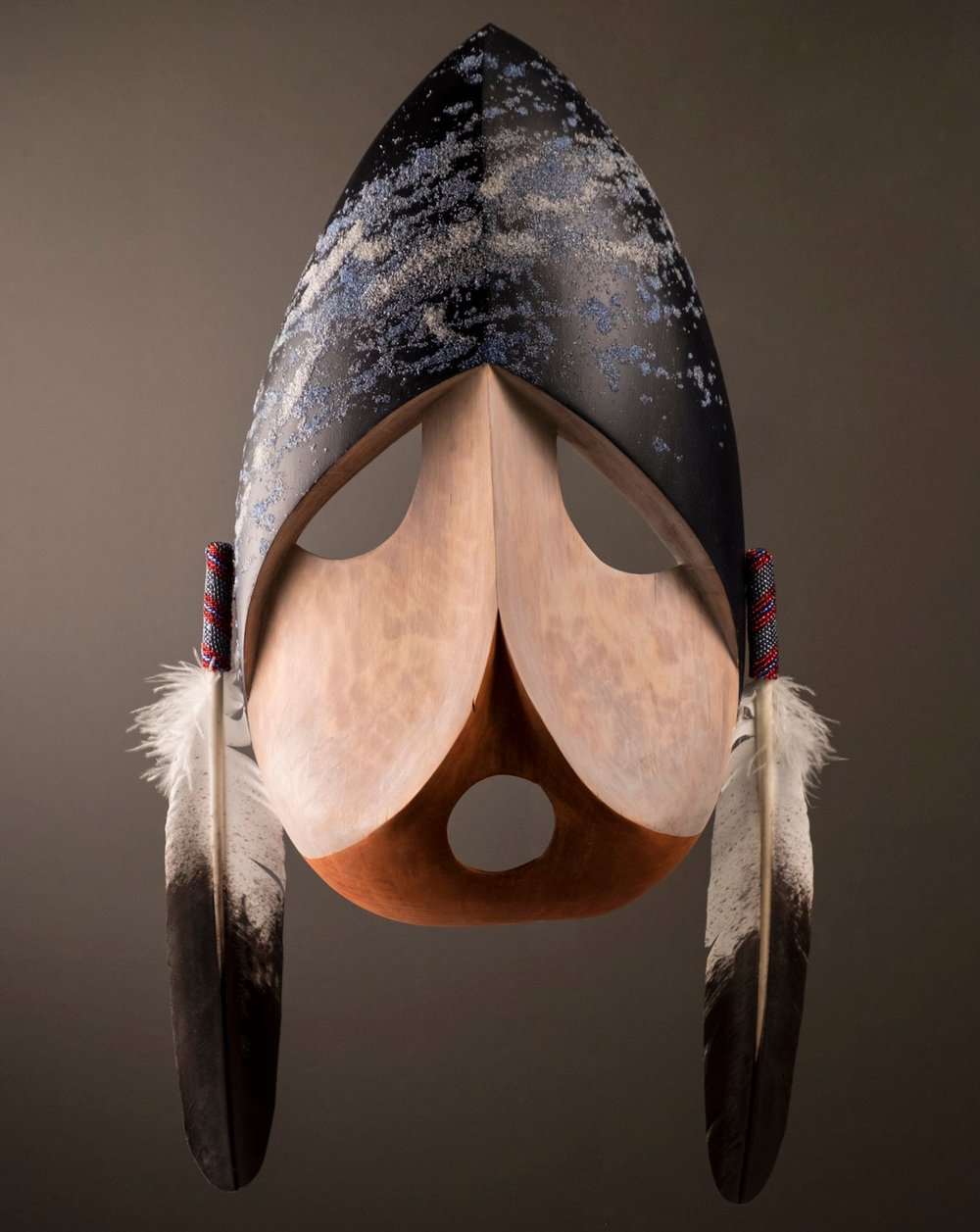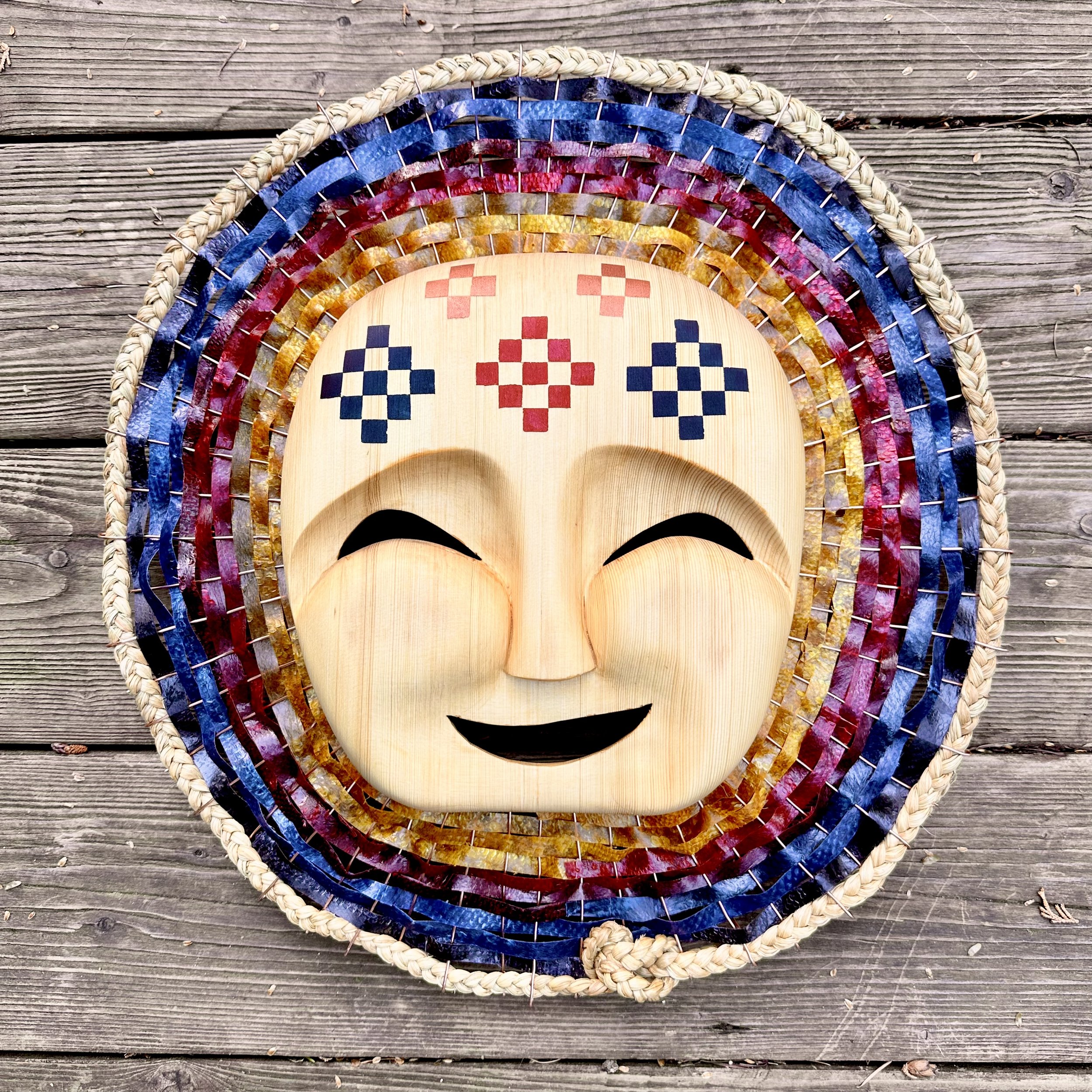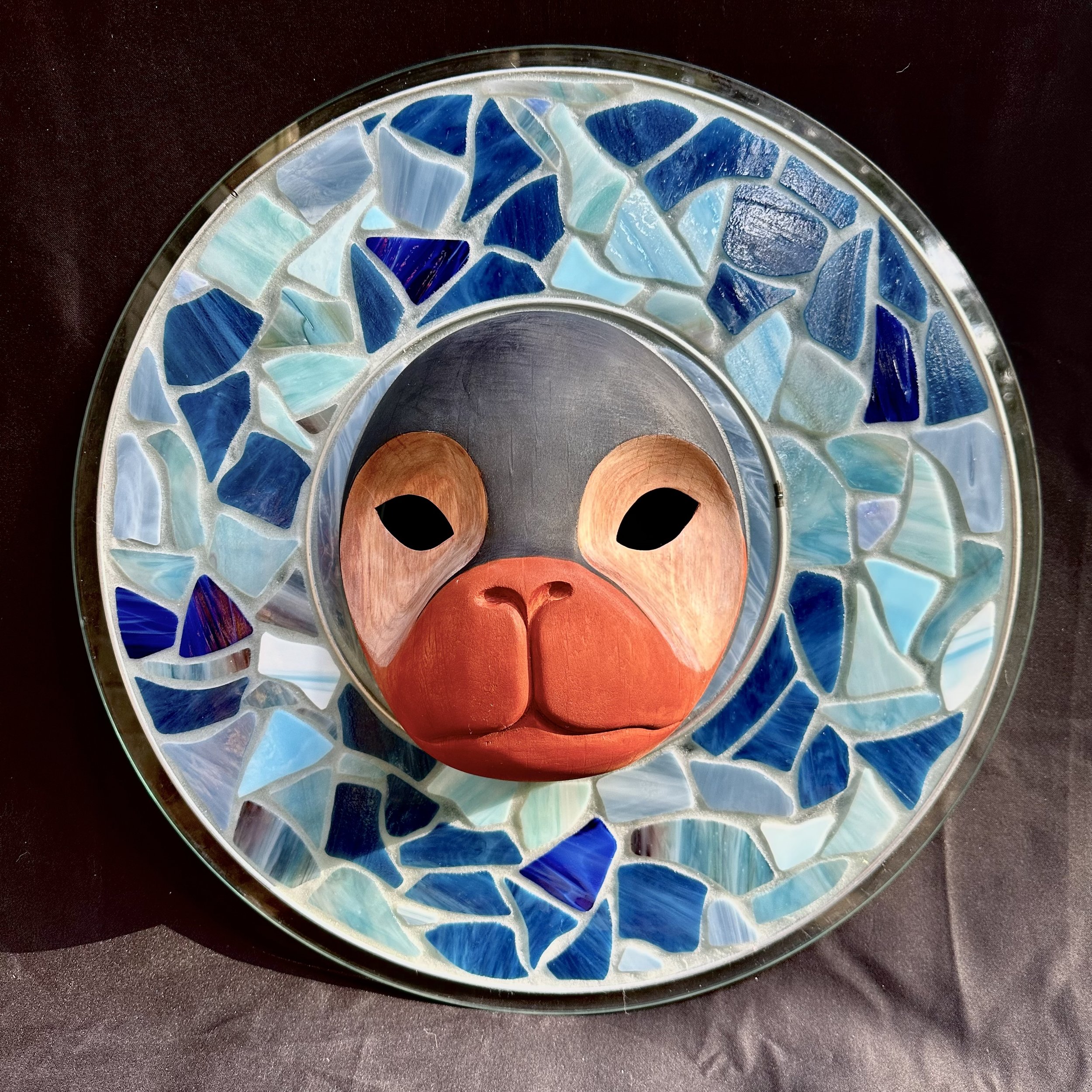Ataucikun - All Together
Yellow cedar, red cedar branches, pigments, salvaged feathers, waxed twine.
24”h x 13”w x 2.5”d
$2600
A central expectation of Yup’ik traditional life is mutual respect between the human, animal/plant, and spirit worlds. Rules were established for human behavior in particular so that the balance between these worlds was maintained and stayed healthy. Misbehavior led to imbalance, which led to the animals, plants, and even driftwood to withhold themselves from the offending people.
These relationships continue today as living relationships. Coastal and river Native peoples continue to advocate for proper care of salmon and other wildlife populations so that they remain healthy and can continue to nourish our communities. The work of these advocates is grounded in our cultural traditions, and I hope their efforts inspire everyone to take part in returning our lands to balance.
Cill’aq-Circular Calendar
Stained glass, lead came, old growth red cedar, pigments, copper wire, chain
24” diameter x 2”d
$3200 - SOLD
The Western calendar, also known as the Gregorian calendar, has a clear beginning and end, and is always presented in a linear fashion. Many Indigenous societies, though, recognized time as cyclical, and many calendars or calendar-like tools show this understanding as a circle. The colors of the glass are intended to represent the changing seasons and the way in which one season melds into the next in a never-ending cycle.
The designs on the mask are intended to represent a deepening of this concept, with the understanding that living in harmony with the world and time also requires an acceptance of the interconnectedness of all things. Preparations for one season do not occur in that season, they have to be done in the previous seasons. We also have to accept that something happening “over here” will absolutely affect something “over there.” As humans, we are not above or below the world around us, we are equal to it.
The circle-and-dot motif on the forehead represents our inextricable place in the universe, the lines above and below the eyes represent air, land and water, and the thick lines around the eyes represent spiritual protection, to prevent us from falling prey to wrong-ways of thinking and behaving.
Raven Saves His Daughter
Basswood, red cedar, basket rings, dowels, feathers, dried seal intestine, acrylic paint, imitation sinew, copper wire, nails.
28"h x 22.5"w x 7.5"d
Auctioned at the Healthy Alaska Natives Foundation’s Raven’s Ball 2024
This mask is based on an old Yup'ik story. One day, Raven's daughter was jigging for tomcod on some shore ice. The ice broke away and she was floating out to sea. Other animals told Raven what they saw, and Raven gathered dirt into the lower part of his shirt and threw it onto the ice. Wherever the dirt fell became land, saving his daughter's life.
This story felt fitting since it's about keeping an eye out for others and doing what we can to help them. Although it is his own daughter that Raven saves, other animals alerted him to the situation so he could help her.
Raven's qaspeq at the top is made of dried seal intestine, and the tomcod, wings and feet are attached by feathers. I observed this method of attaching pieces during my artist visit at the Burke Museum at the University of Washington in Seattle, WA.
Kuvyi~ - To Make a Net
Alder, Dowels, Wooden Hangers, Copper Wire, Dyed Horn Beads, Acrylic Paint
16"h x 18"w x 5"d
$3800 - Available at Stonington Gallery
The design of this mask is based on an old Yup’ik ivory or bone net shuttle. Net shuttles are simple but important tools used to hold the material used for weaving nets. These tools are found throughout the world, both in history and the modern day, and my ancestors used them to make nets to catch fish and birds.
Shuttles can also be used to mend damaged nets, which is the idea that inspired this mask. Nets get damaged as part of their normal use, but they are not tossed aside once this happens. Instead, the hole is repaired, sometimes with the original material and sometimes with a substitute. The important aspect is that the net continues to do its work, whether or not it looks and feels as it once did. This piece is about mending our own nets, and maybe even sometimes making new ones, but continuing on as we find ways to heal and make ourselves whole again.
In terms of materials and design, white, red, and blue (as well as black) are the most common colors traditionally used on Yup'ik masks. The designs on the seals are inspired by the original artifact and other Yup'ik line design. The copper is an offering to our ancestors, which is a teaching I learned from Yup'ik elder Chuna McIntyre's work.
Kellarvik - Grass Basket
Yellow cedar, acrylic paint, home-tanned and -dyed salmon skin, copper wire, vintage braided beach grass
16”w x 16.5”h x 2 3/4”d
$3200 - SOLD
My grandma created beautiful baskets out of the beach grass that grows abundantly around Tununak, AK. I spent countless hours watching her expertly weave and sew each basket, observing how she prepared the grass and pulled out small bundles from the plastic bag at her side. The shape of the mask is based on the outline of one of these types of baskets, and the design on the forehead is a common geometric pattern found across the Yup'ik region. I tanned the salmon skins and chose to dye them in colors that made me think of the sharing and passing down of knowledge between generations. The braided grass around the outer rim is from an old Yup'ik storage basket gifted to me by some lifelong friends. I used copper wire as an offering to my ancestors, which is a teaching I learned from watching a video of Yup'ik culture bearer Chuna McIntyre.
Checking in II
Alder, stained glass, plate glass, metal rings, grout, pigments
20” diameter x 4” deep
$2800 - SOLD
This mask relates to the story of the boy who lived with the seals for a year. He was transformed into a seal during this time, and the seals taught him the correct ways of living in exchange for offering themselves to humans for food and material resources. After the year was over, the boy turned back into a human and was responsible for teaching his community the rules he learned. Since that time, seals continue to check up on us to ensure that we are upholding our agreed-upon responsibility.






